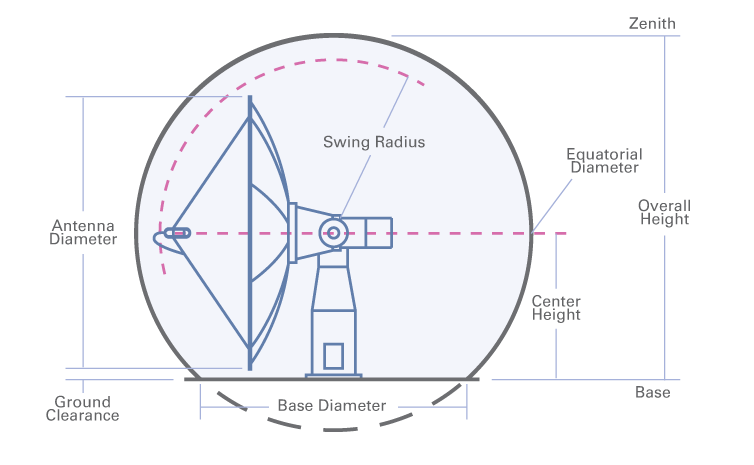PROPER RADOME SIZING
We offer many radomes that have a spherical shape with a truncation or height usually between 80% and 90% of the radome's diameter. Radome diameter and truncation are primarily driven by antenna size and type. Although the exact radome size is determined by the specific antenna, some basic assumptions can be made to aid in obtaining a rough radome size. For preliminary design estimates, the following assumptions may be used.
Antenna specific assumptions for radome diameter selection considerations:
- Prime Focus antenna - equal to 1.5 times the reflector diameter
- Offset Feed antenna - equal to 2.3 times the reflector diameter
Prime Focus Feed Antenna
An on axis type antenna is a parabolic or nearly parabolic shape with a focal length verses antenna diameter (f/D) usually in the range of 0.4. Other features:
- Cassegrain or Gregorian fed parabolic dish antenna
- Pedestal mounted collocated elevation and azimuth axis
- Antenna axis located in the geometric center of the radome
Offset Feed Antenna
An offset feed type antenna is a smaller segment of a parabolic dish with a much greater focal length than a similar sized prime focus antenna. For this style of antenna, use of a radome diameter equal to 2.3 times the reflector diameter is necessary.
These sizing assumptions have been shown to provide a realistic estimate for a suitable sized radome that will provide the following:
- Unrestricted range of motion for the antenna
- Clearance at zero degrees antenna elevation from reflector edge to ground
- Clearance for cabling and maintenance activities
Truncation
Truncation is the height of the radome measured from the base mounting surface to zenith and is expressed as a percentage of the radome diameter. ITI-RCS offers a variety of truncations ranging from less than 60% to approximately 90% to aid in matching user requirements.
On Axis Example
Selection of the correct truncation is critical in achieving optimum RF performance. Ideally, the center of the radome and the center of the antenna's elevation and azimuth axis for dish type systems should be collocated when using the on axis method. This arrangement ensures the antenna is always looking through the radome wall uniformly on either side of the center ray minimizing the radome’s impact on key performance characteristics. The truncation will equal to half the radome diameter plus the radome center height divided by the radome diameter (expressed as a percentage). Radome center height is equal to half the diameter of the reflector plus 1ft [305mm] ground clearance. on axis Example

Other antenna types such as dish systems that have separate elevation and azimuth axis positions and phased-array systems should be evaluated and placed within the radome to minimize system performance degradation which will sometimes use an offset truncation. As a general rule, a truncation equal to or less than 80% is commonly used for this application.
Although a useful tool for general estimating, no general guideline can cover all possible radome configurations. ITI-RCS strongly recommends our customers provide dimensional information on the specific antenna system for assistance in selecting a properly sized radome. ITI-RCS can also help when there is more than one antenna under the radome. The shape can be optimized for multiple antenna systems and the degree that the radome affects each enclosed system should be evaluated if this is the case.
In instances where the antenna is fixed in position or has a limited range of movement radome size can usually be decreased.
Antenna dimensional information most useful in correctly sizing a radome includes:
- Dish diameter
- Swing radius
- Height from ground to elevation and axis locations
- Relationship between elevation and azimuth axis
- Manufacturer model number
